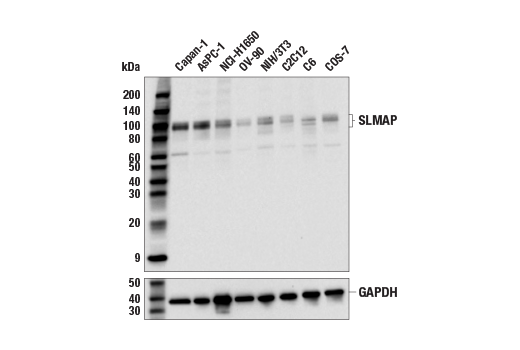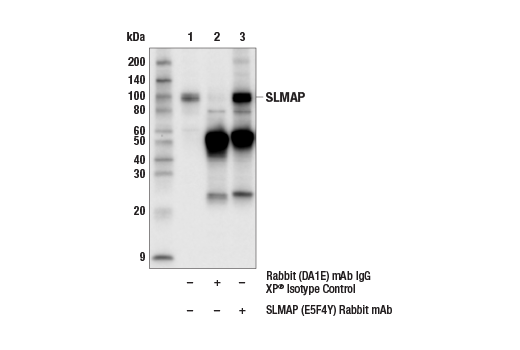WB, IP
H M R Mk
Endogenous
90-95
Rabbit IgG
#Q14BN4
7871
Product Information
Product Usage Information
| Application | Dilution |
|---|---|
| Western Blotting | 1:1000 |
| Immunoprecipitation | 1:50 |
Storage
Specificity / Sensitivity
Species Reactivity:
Human, Mouse, Rat, Monkey
Source / Purification
Monoclonal antibody is produced by immunizing animals with a synthetic peptide corresponding to residues surrounding Thr462 of human SLMAP protein.
Background
Sarcolemmal membrane-associated protein (SLMAP) is a tail-anchored membrane protein involved in the docking and membrane fusion process (1). It is also a component of a conserved striatin-interacting phosphatase and kinase complex (STRIPAK) which participates in a variety of cellular processes, including signaling, cell cycle control, cell migration, Golgi assembly, and apoptosis (2-4). There are several isoforms of SLMAP as a result of alternative splicing; shorter isoforms exhibit high expression in cardiac muscle, whereas the longer isoforms are expressed more ubiquitously, but at lower levels (5). As a cardiac membrane protein, SLMAP plays an important role in excitation-contraction coupling and the adrenergic response, and has been identified as a novel regulator of cardiac function (6-8). In support of that function, mutations in the SLMAP gene are associated with Brugada syndrome, a cardiac channelopathy (9). Deregulation of SLMAP expression has also been implicated in type 2 diabetes, and changes in SLMAP expression are linked to hyperglycemia and diabetes (10). Additionally, a novel SLMAP-ALK fusion has been identified in a patient with non-small cell lung cancer (11).
- Goudreault, M. et al. (2009) Mol Cell Proteomics 8, 157-71.
- Hwang, J. and Pallas, D.C. (2014) Int J Biochem Cell Biol 47, 118-48.
- Shi, Z. et al. (2016) Oncogene 35, 4549-57.
- Tang, Y. et al. (2019) Cell Discov 5, 3.
- Wigle, J.T. et al. (1997) J Biol Chem 272, 32384-94.
- Guzzo, R.M. et al. (2005) Am J Physiol Heart Circ Physiol 288, H1810-9.
- Nader, M. et al. (2012) Am J Physiol Heart Circ Physiol 302, H1138-45.
- Nader, M. (2019) Eur J Pharmacol 858, 172491.
- Ishikawa, T. et al. (2012) Circ Arrhythm Electrophysiol 5, 1098-107.
- Ding, H. et al. (2005) Am J Physiol Heart Circ Physiol 289, H206-11.
- Pagan, C. et al. (2019) Cold Spring Harb Mol Case Stud 5, a003939. doi: 10.1101/mcs.a003939.
Species Reactivity
Species reactivity is determined by testing in at least one approved application (e.g., western blot).
Western Blot Buffer
IMPORTANT: For western blots, incubate membrane with diluted primary antibody in 5% w/v nonfat dry milk, 1X TBS, 0.1% Tween® 20 at 4°C with gentle shaking, overnight.
Applications Key
WB: Western Blotting IP: Immunoprecipitation
Cross-Reactivity Key
H: human M: mouse R: rat Hm: hamster Mk: monkey Vir: virus Mi: mink C: chicken Dm: D. melanogaster X: Xenopus Z: zebrafish B: bovine Dg: dog Pg: pig Sc: S. cerevisiae Ce: C. elegans Hr: horse GP: Guinea Pig Rab: rabbit All: all species expected
Trademarks and Patents
Limited Uses
Except as otherwise expressly agreed in a writing signed by a legally authorized representative of CST, the following terms apply to Products provided by CST, its affiliates or its distributors. Any Customer's terms and conditions that are in addition to, or different from, those contained herein, unless separately accepted in writing by a legally authorized representative of CST, are rejected and are of no force or effect.
Products are labeled with For Research Use Only or a similar labeling statement and have not been approved, cleared, or licensed by the FDA or other regulatory foreign or domestic entity, for any purpose. Customer shall not use any Product for any diagnostic or therapeutic purpose, or otherwise in any manner that conflicts with its labeling statement. Products sold or licensed by CST are provided for Customer as the end-user and solely for research and development uses. Any use of Product for diagnostic, prophylactic or therapeutic purposes, or any purchase of Product for resale (alone or as a component) or other commercial purpose, requires a separate license from CST. Customer shall (a) not sell, license, loan, donate or otherwise transfer or make available any Product to any third party, whether alone or in combination with other materials, or use the Products to manufacture any commercial products, (b) not copy, modify, reverse engineer, decompile, disassemble or otherwise attempt to discover the underlying structure or technology of the Products, or use the Products for the purpose of developing any products or services that would compete with CST products or services, (c) not alter or remove from the Products any trademarks, trade names, logos, patent or copyright notices or markings, (d) use the Products solely in accordance with CST Product Terms of Sale and any applicable documentation, and (e) comply with any license, terms of service or similar agreement with respect to any third party products or services used by Customer in connection with the Products.

